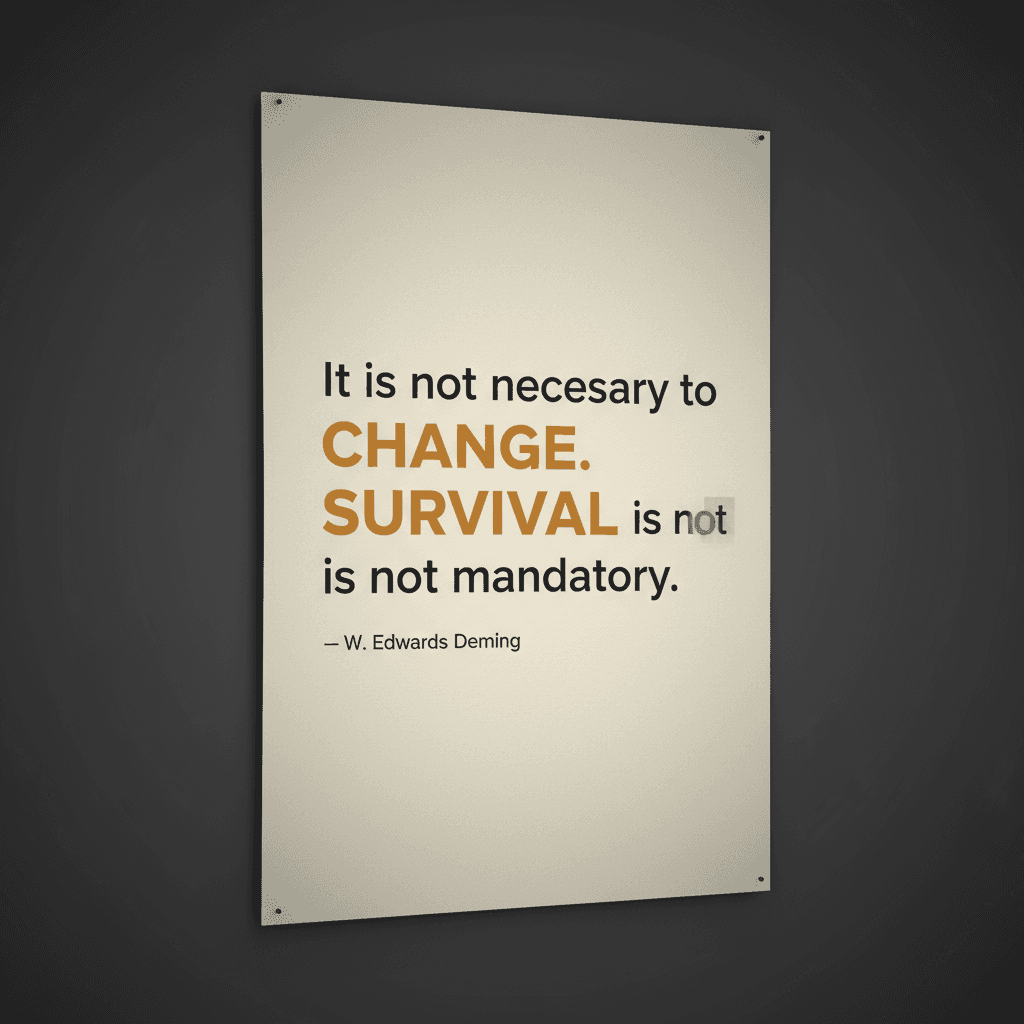Change or Perish: Deming’s Stark Choice

It is not necessary to change. Survival is not mandatory. — W. Edwards Deming
Change as a Deliberate Decision
Deming’s aphorism strips away comforting illusions: organizations are free to ignore change, but not its consequences. Emerging from his postwar work on quality and systems, Deming argued that performance is largely a product of the system, not individual heroics (Out of the Crisis, 1982). Thus, choosing not to improve is effectively choosing the trajectory of decline. By reframing change as optional, he removes excuses while placing responsibility squarely on leaders to create conditions where adaptation is possible and expected.
Adaptation, Not Strength, Ensures Survival
From this premise, the logic widens to markets and ecology. While often paraphrased as Darwin, the core idea is sound: survival favors responsiveness to shifting environments. Joseph Schumpeter’s creative destruction (Capitalism, Socialism and Democracy, 1942) explains how new combinations displace the old, regardless of past dominance. In this frame, stability is not safety; it is exposure. When environments destabilize—through technology, regulation, or consumer taste—the capacity to learn faster than conditions change becomes the decisive advantage.
Lessons from Corporate Evolution
History illustrates the cost of ignoring inflection points. Kodak pioneered digital photography in 1975 but clung to film economics, filing for bankruptcy in 2012 despite early invention. Blockbuster’s late pivot ceded ground to Netflix, which itself transitioned from DVDs to streaming before growth stalled. In contrast, IBM reoriented from hardware to services and software under Lou Gerstner, as recounted in Who Says Elephants Can’t Dance? (2002). These cases show Deming’s choice in action: institutions either revise their identity to fit the future or become artifacts of the past.
Turning Change into a System
To make adaptation repeatable, Deming promoted methods that convert learning into routine: statistical process control, the Plan–Do–Check–Act (PDCA) cycle, and his 14 Points. Toyota’s kaizen and the Toyota Production System (Taiichi Ohno, 1978) operationalized these ideas by empowering frontline workers to surface defects and improve flow. In this design, feedback is not a postmortem; it is a continual pulse. Consequently, change shifts from episodic disruption to everyday refinement, lowering risk while raising resilience.
Why We Resist: The Human Factor
Yet change is hard because people are wired for the status quo. Loss aversion magnifies perceived costs (Kahneman and Tversky, 1979), while status quo bias sustains existing choices (Samuelson and Zeckhauser, 1988). Kurt Lewin’s unfreeze–change–refreeze model (1947) and John Kotter’s eight steps (1996) address these frictions by creating urgency, building coalitions, and anchoring new behaviors in culture. When leaders reduce fear, clarify purpose, and make progress visible, resistance softens into participation.
Making Adaptation Actionable
Thus leaders can institutionalize agility with disciplined practices: run small bets, define kill criteria, and privilege leading indicators over lagging comfort. John Boyd’s OODA loop (observe–orient–decide–act) emphasizes faster learning cycles, while discovery-driven planning (Rita Gunther McGrath and Ian MacMillan, 1995) budgets for assumptions and pivots early. By treating strategy as a testable hypothesis rather than a fixed decree, organizations turn uncertainty from a threat into fuel for iteration.
The Ethical Stakes of Staying Still
Ultimately, Deming’s axiom carries moral weight. Choosing not to change risks customers’ trust, employees’ livelihoods, and communities’ welfare—particularly as safety, climate, and cybersecurity stakes rise. Continuous improvement safeguards more than margins; it protects people. Therefore, survival as a value implies an obligation: to learn, to adapt, and to build systems that make tomorrow safer and more useful than today. In that light, change is optional only if responsibility is, too.